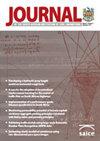A development cost comparison between a multi-storey mass timber and reinforced concrete building in South Africa
IF 0.6
4区 工程技术
Q4 ENGINEERING, CIVIL
Journal of the South African Institution of Civil Engineering
Pub Date : 2021-12-31
DOI:10.17159/2309-8775/2021/v63n4a4
引用次数: 1
Abstract
High-rise timber buildings have experienced a resurgence internationally during the past two decades. This paper presents an investigation into the financial feasibility of a multi-storey mass timber building for South Africa through a development cost comparison. Two 8-storey commercial buildings - a mass timber frame and a reinforced concrete frame - were first designed by independent engineering consultants. A focus group workshop, conducted with industry professionals, assisted with the development of construction schedules. Subsequently, a financial model was developed to determine the overall development cost and financial feasibility of each option. Finally, a sensitivity analysis was conducted to investigate the effect ol certain variables on the overall profitability of the mass timber frame development. The focus group workshop identified that the construction of the reinforced concrete frame building and mass timber frame building will take 42 weeks and 21 weeks, respectively. The total capital investment required for the mass timber frame development was found to be 10% more than that of the reinforced concrete frame development (R115 691 000 versus R 105 118 000). A five-year internal rate of return (IRR) of 20.9% and 25.7% was calculated for the mass timber and reinforced concrete frame developments, respectively. A significant finding of the sensitivity analysis was that the mass timber frame building proved to generate a higher five-year IRR than that of the reinforced concrete frame once the mass timber building achieved a rental premium of 7.8% or more. The sensitivity analysis further showed that the importation of the mass timber elements remains an expensive option, with a 16.4% five-year IRR for the imported mass timber frame (at a R17:€1 exchange rate).南非多层大块木材和钢筋混凝土建筑的开发成本比较
在过去的二十年里,高层木结构建筑在国际上重新兴起。本文通过开发成本比较,对南非多层木结构建筑的财务可行性进行了调查。两座8层高的商业建筑——一个是木结构,一个是钢筋混凝土框架——最初是由独立的工程顾问设计的。由业界专业人士举办的焦点小组讲习班协助制订建造时间表。随后,开发了一个财务模型,以确定每个选项的总体开发成本和财务可行性。最后,进行了敏感性分析,以调查某些变量对大型木结构开发整体盈利能力的影响。焦点小组研讨会确定,钢筋混凝土框架建筑和大质量木结构建筑的建造将分别耗时42周和21周。大型木结构框架开发所需的总资本投资比钢筋混凝土框架开发所需的总资本投资多10%(115 691 000卢比对105 118 000卢比)。大型木材和钢筋混凝土框架项目的五年内部收益率(IRR)分别为20.9%和25.7%。敏感性分析的一个重要发现是,一旦大型木结构建筑的租金溢价达到7.8%或更高,则证明大型木结构建筑的五年内部收益率高于钢筋混凝土框架建筑。敏感性分析进一步表明,进口大量木材构件仍然是一个昂贵的选择,进口大量木材框架的五年内部收益率为16.4%(按R17:€1汇率计算)。
本文章由计算机程序翻译,如有差异,请以英文原文为准。
求助全文
约1分钟内获得全文
求助全文
来源期刊
CiteScore
0.70
自引率
25.00%
发文量
19
审稿时长
>12 weeks
期刊介绍:
The Journal of the South African Institution of Civil Engineering publishes peer reviewed papers on all aspects of Civil Engineering relevant to Africa. It is an open access, ISI accredited journal, providing authoritative information not only on current developments, but also – through its back issues – giving access to data on established practices and the construction of existing infrastructure. It is published quarterly and is controlled by a Journal Editorial Panel.
The forerunner of the South African Institution of Civil Engineering was established in 1903 as a learned society aiming to develop technology and to share knowledge for the development of the day. The minutes of the proceedings of the then Cape Society of Civil Engineers mainly contained technical papers presented at the Society''s meetings. Since then, and throughout its long history, during which time it has undergone several name changes, the organisation has continued to publish technical papers in its monthly publication (magazine), until 1993 when it created a separate journal for the publication of technical papers.

 求助内容:
求助内容: 应助结果提醒方式:
应助结果提醒方式:


